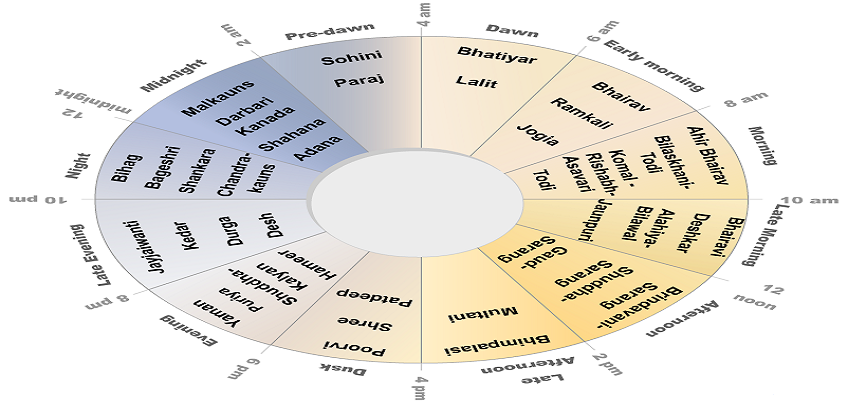

This quote says it all! Hindustani Classical Music system is rooted deep in traditions. One of the mandatory rules followed is the ‘Ashta Prahar’ or ‘Time cycles’.
In the olden days where no clocks existed, the activities of the day were planned around the movement of the sun. Accordingly, time cycles known as ‘prahars’ came into existence.
Let us understand the concept of ‘prahars’ and their importance in our music. A day is divided into 2 parts of 4 sections each. 4 ‘prahars’ for the day and 4 ‘prahars’ for the night. Sunrise symbolises the start of the first ‘prahar’ while Sunset implies the end of the 4th ‘prahar’. Then on, between sunset and sunrise, the balance 4 ‘prahars’ get unfolded. To summarise, a day is divided into 8 ‘prahars’ of 3 hours each.
Hindustani Music adapted itself to match these time cycles and ragas got distributed as per the characteristics of their ‘swaras’. These ragas then got classified into groups called Prathakaal, Madhyana, Sandhiprakash, and so on. In the process, a system got established wherein specific ragas are prescribed to be performed during a particular ‘prahar’, to optimise their aesthetic effects. Pt. V. N. Bhatkande (1860-1936) a scholar of Indian Classical Music, in his works states that the ‘prahar’ or correct time to play a raga, has a relation to its scale.
It will be interesting to understand this connection between a raga’s scale and time of day. A person’s mind set and activities are closely linked to the movement of the sun. The early morning hours are full of freshness and silence. There is a higher ozone level in the atmosphere, one is fresh after a good night’s rest and usually takes his/her time to go about one’s activities. The ragas chosen for this time frame are the ones with more ‘andolan’. Soon after sunrise, the day is bright and tempo picks up. Ragas with firmer ‘swaras’ are chosen for this phase. Also the ones that lend themselves to a melodic rise in tempo. This is commensurate with a person’s daily activities as he/she gets ready to begin the day in full earnest. The afternoon ragas are ones with slower melodies while the ones performed during sunset are melancholic. As night approaches, the mood shifts and ragas with a corresponding emotion are rendered. Here it is important to note that during ‘riyaaz’ any raga can be practised. The ‘prahar’ does not matter. Choice of raga based on ‘prahar’ is to be maintained only during a performance.
An age-old classification indicating the flow of ragas, studied by the masters of yesteryears has also been included in the App. Here’s a brief explanation:
It is very important for every student to understand this as this will help him/her decide which raga is to be performed on a multi-artiste performance stage.
In the myGurukul App, the ‘Ashta Prahar’ section is curated for advance level students. 10 ragas from the 8 ‘prahars’ have been put out for the students to understand the nuances and practice regularly. The ragas included in this section are Todi, Miyan Malhar, Darbari, Jaijaiwanti, Jog, Marwa, Bhairav, Shuddha Sarang. In this module the student is also introduced to Vilambit Ektaal and is taught to play to its accompaniment.
Coming to the Flute, it is well-known how difficult it is to play ragas comprising Komal ‘Re’ and Komal ‘Dha’. In fact, all the above mentioned ragas are quite a challenge to be rendered on the Flute. But the way the lessons have been structured on the App, make it much simpler than it actually seems. When a student desires to play any raga, he yearns to play a variety of phrases, with the right amount of ornamentation, and an effortless style of presentation. These very offerings make myGurukul a unique platform for the discerning student.
Once the student has successfully completed this module, he/she is equipped to play at least one raga per ‘prahar’. And this is indeed a huge achievement for any learner.
Additionally, students from Gandharva Maha Vidyalaya, Prayag Sangit Vidyalaya, or students from Music University will also benefit from this module.
The ‘Ashta Prahar’ module is one that not only teaches you to render ragas on the Flute, but also helps you understand the science behind this age-old tradition. Come, get enriched!